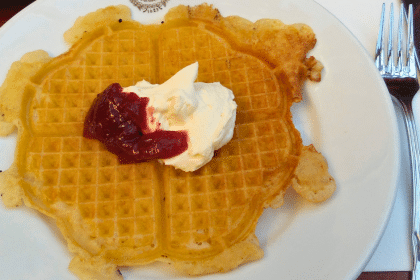Are you a fan of sweet treats and Scandinavian traditions? Then you need to discover the semla, an irresistible Swedish delicacy that captures hearts every year, both in Sweden and internationally. These fluffy buns, filled with a heavenly combination of creamy whipped cream and sweet almond paste, are the culinary stars of Fettisdagen, the Swedish equivalent of Shrove Tuesday.
What is a semla?
A semla (plural: semlor) is a soft, light bun with a hollow centre filled with a delectable blend of whipped cream and almond paste. The bun is topped with a sugary lid, created by cutting off the top and then dusting it with icing sugar before replacing it.
Traditionally enjoyed on Fettisdagen – the day before the start of Lent – semlor are now a beloved treat readily available in Swedish bakeries from Christmas through to Easter. They are also affectionately known as Fettisdagsbullar.
Interesting Fact: The word “semla” originates from the Latin “semilla”, meaning “fine flour” or “flour of the highest quality”. This perfectly encapsulates the delicate, soft texture of these delightful buns.
How Swedes enjoy their semla
The classic way to savour a semla is to accompany it with a bowl of warm milk. This comforting combination, known as hetvägg, provides a delightful warmth on chilly winter days. Of course, enjoying a semla straight from the hand is equally delicious!
Swedes undeniably adore their semlor: an astonishing 40 million are sold annually, translating to over four semlor per person! Although semlor are now available earlier in the season (sometimes even around Christmas), their presence invariably concludes after Easter.
Modern semla variations
Swedish bakers are renowned for their creativity, and the semla is no exception. Recent years have witnessed the emergence of innovative variations, such as the semmelwrap (a modern take on the traditional bun) and intriguing fusions like the princess cake-semla hybrid. The nachosemla, a unique creation from Mr. Cake, further demonstrates the boundless creativity within the Swedish baking scene.
Fettisdagen: the Day of the Semla
Fettisdagen, the Swedish equivalent of Shrove Tuesday, is a day dedicated to indulgence before the 40-day Lenten fast. While pancakes are the traditional Shrove Tuesday treat in many countries, Swedes opt for the delightful Fettisdagsbullar, or semlor. This cherished tradition has even earned Fettisdagen the alternative name of Semmeldagen, highlighting the central role of these delectable pastries.
When is Fettisdagen or Shrove Tuesday in Sweden?
- 2025: 4 March
- 2026: 17 February
- 2027: 9 februari
- 2028: 29 februari
- 2029: 13 februari
- 2030: 5 maart
If you are not traveling to Sweden during this period, you can already get started at home with the recipe below:
Classic recipe for semlor
Ingredients
For the bullar
- 75 grams of butter
- 300 ml milk
- 10 g of yeast
- half a teaspoon of salt
- 55 g of sugar
- a teaspoon of cinnamon
- 500 grams of flour
- 1 egg
For the filling
- 200 grams almond paste (mandelmassa in Swedish)
- 120 ml milk
- cream
- icing sugar
Make your own mandelmassa
You can also make your own almond paste (or mandelmassa). For this, mix 1 part peeled and ground almonds with 1 part icing sugar. So, for this recipe, use 100 grams of ground almonds and 100 grams of icing sugar. Then add a few drops of water until you achieve a firm consistency.
Preparation
- Warm milk and butter: Heat the milk and butter in a saucepan until the butter melts. Add the yeast to this mixture.
- Combine dry ingredients: In a large bowl, mix together all the dry ingredients.
- Form the dough: Pour the contents of the saucepan (with the melted butter and yeast) and the egg into the bowl with the dry ingredients. Knead for five minutes until you have a smooth dough that no longer sticks to your fingers.
- First rise: Cover the dough and let it rise for half an hour in a warm place.
- Shape the buns: Once risen, knead the dough into balls. Remember that the dough will continue to rise, so don’t place the buns too close together. Cover again and let them rise for another 30 minutes.
- Egg wash: Brush the tops of the buns with beaten egg or milk.
- Bake: Preheat the oven to 200 degrees Celsius (400 degrees Fahrenheit). Baking time will vary depending on the size of the buns, but should be between 10 and 25 minutes. Remove from the oven and let them cool completely.
Filling
While the buns are cooling, prepare the filling. Since I couldn’t find almond paste, I used marzipan.
- Grate the almond paste
- Combine filling ingredients: Once the buns are cool, carefully cut off the top of each bun. Use a fork to gently remove the middle of each bun.
- Mix filling: In a bowl, combine the grated marzipan, breadcrumbs, and milk. Mix well until you have a firm, cohesive filling that is no longer runny.
- Fill the buns: Fill each bun cavity with the marzipan mixture.
Finishing Touches
- Top with cream: Top each filled bun generously with whipped cream.
- Replace the tops: Place the cut-off tops of the buns back on.
- Dust with sugar: Dust the tops of the finished buns with powdered sugar.
Traditional Serving
For a truly traditional experience, place each semla in a deep plate and pour hot milk around it.
Enjoy!
Pin it: recipe Swedish semla
Save for later!







How many buns should this recipe make? Wondering how to divide the dough.